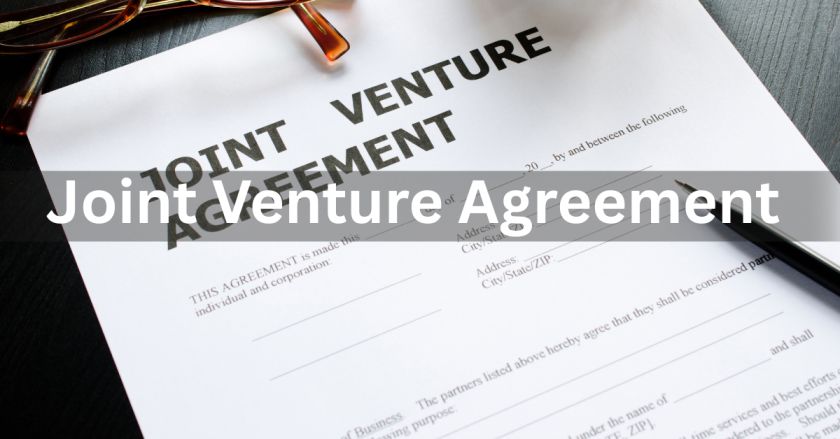Every growth-focused business faces a key question: should they expand on their own or partner with others to reach new markets, share risks, and gain new expertise?
One way to expand is to tie up with a partner and enter new areas of business. This is called a “Joint Venture”. The agreement that is executed for it is called a “Joint Venture Agreement”. It is a legally binding contract that defines how two or more parties collaborate on a specific business goal while keeping their independent identities intact.
For business leaders, a Joint Venture Agreement is more than just legal paperwork. It protects their investment, defines who controls what, and keeps both sides motivated towards achieving the same goal. A clear JV agreement is the backbone of a productive partnership that will help the business to grow. This guide explains what a Joint Venture Agreement is, how it is structured, and the common types of agreements that are commonly used by enterprises.
What Is A Joint Venture Agreement?
A joint venture agreement is a type of contract in which two or more entities agree to work together on a project or business venture. Both of them contribute resources to the venture in the form of funds, materials, machinery, labour, technology, expertise, etc. to help the business grow. They also share the profits and losses between themselves in a ratio agreed upon at the time of entering into the contract.
It is completely different from mergers and acquisitions. In the joint venture no single merged entity is formed. Instead, the participating businesses remain separate and continue to function as independent entities. They just collaborate in the joint venture under the terms agreed upon in a well-defined contract.
Joint venture contract help the participating companies to pursue shared goals, such as entering new markets, launching new products or pooling resources for innovation, without having to let go of the control of their individual operations.
A joint venture agreement can be a contractual agreement which is based purely on an agreement or an equity-based agreement where both parties form a new company. In either case the joint venture agreement dictates how the decisions will be made, profits will be distributed, and disputes will be resolved.
Why Is A Written Joint Venture Agreement Needed?
Trust and clarity are the two pillars on which every joint venture stands. A written joint venture agreement clearly documents the roles, responsibilities, and rights of each party so that no confusion arises later.
This surety is of utmost importance in any business venture, as it results in greater trust, smoother operations, minimum disputes and a strong partnership that lasts for a long period of time.
The Key Elements Of A Joint Venture Agreement
For a Joint Venture Agreement to be legally valid, it must the following elements:
1. Parties And Structure
Every JVA begins with clarity about who is involved. The agreement must mention the names of all the parties entering into the contract, describe their legal status, and define the type of venture they are entering into. Getting this right prevents confusion about control and responsibility later.
2. Purpose And Scope
The agreement must mention why the venture is being created, the goals it will achieve and the duration for which it will be valid. Defining the purpose clearly keeps both sides focused on it and prevents the project from drifting away from its original goals.
3. Funds And Other Resources
Without the availability of the essential resources and appropriate funding, no joint venture can be successful. Hence, the contribution of each partner, in the form of cash, assets, or expertise, should be mentioned in the agreement.
4. Profit And Loss Sharing
The goal of any business venture is to earn profits. The Joint Venture Agreement must specify the ratio in which the profits and losses from the JV will be shared by the partners. This ratio must be decided before starting the work, so that there are no misunderstandings later.
5. Governance And Decision Making
Good governance keeps a venture running smoothly. Hence, the agreement should clearly outline who will manage the daily operations of the joint venture, how voting will be done, and which decisions will require joint approval. This is necessary for preventing deadlocks and maintaining accountability.
6. Duration And Termination
Most collaborations last for a limited period and a date of completion is decided from the beginning. The agreement must mention the duration of the venture and the circumstances under which it can end. This will help in avoiding confusion later.
7. Dispute Resolution
Even the strongest partnerships sometimes give rise to disagreements. The agreement should define how disputes will be handled, whether through discussion, mediation, arbitration, or court. Many businesses prefer arbitration because it offers privacy and faster outcomes.
8. Confidentiality And Intellectual Property Rights
In a joint venture, the partners share technology, data, or processes with each other. Hence, protecting that knowledge is essential. This clause explains who owns what and how information can be used. Safeguarding intellectual property rights maintains their trust and protects the competitive advantage of the business.
9. Exit And Buyout Options
It may happen that one of the partners in the joint venture may want to exit it at a later date due to some reason. Hence, the agreement must mention how a partner can exit from the joint venture, transfer ownership, or buy out the stake of the other party. Planning partner exits at the time of creating the venture keeps transitions smooth and helps avoid costly disputes in the future.
10. Standard Legal Clauses
Finally, standard contractual provisions such as force majeure, governing law, notices, and amendment procedures give the agreement its legal completeness. These will protect the venture from unexpected events, such as natural disasters, policy changes, or political instability.
Together, these clauses define not only how a joint venture will operate but also how it will adapt when things change. A carefully structured JVA will give the shared business interests of the parties a strong legal framework that will help them to achieve their long-term business goals without any hindrance.
Different Types Of Joint Ventures
Joint ventures can take many forms, depending on the goal, industry, and level of collaboration between the parties. The companies must understand these types, to be able to choose the right structure for their joint venture business.
1. Equity Joint Ventures
In an equity joint venture, a new company is created and the partners invest their capital in it. This model is ideal for large ventures like power generation and infrastructure companies, which are capital intensive in nature.
2. Contractual Joint Ventures
Contractual joint ventures are ideal for low-risk projects that can be completed without having to set up a new company. The parties collaborate on the basis of the contract but otherwise remain legally independent of each other.
3. Project-Based Joint Ventures
A project-based venture is formed to complete a single assignment, such as a construction or real estate project. Once the work is finished, the venture ends. It is a flexible option with clear start and end points.
4. Function-Based Joint Ventures
Sometimes two companies want to collaborate in one area of the business only while continuing to run the rest of it independently. Some business functions where this collaboration is commonly seen are research and development, marketing and logistics. These are called function-based joint ventures
5. Vertical Joint Ventures
A vertical joint venture is created between two companies at different stages of the value chain, for example a raw material supplier and a manufacturer. These joint ventures integrate different stages of the value chain, optimize costs, and leverage each partner’s strengths
6. Horizontal Joint Ventures
When a business wants to grow further, they adopt new strategies like developing a new product or venturing into new markets. However, it may be difficult to do this alone. In such cases it gets into a horizontal joint venture with another company to do this together. This reduces the competition between them and enables them to grow faster by pooling in their resources.
7. International Joint Ventures
When businesses from different countries collaborate, they form an international joint venture. This helps foreign companies enter new markets by sharing local expertise, compliance understanding, and distribution networks.
The companies wanting to enter into a joint venture must think of the strategic goal of the parties, their capacity to invest, and the regulatory environment while selecting the type they must choose. The right structure of joint ventures builds synergy without compromising independence.
Pros and Cons of Joint Ventures
Joint ventures can provide major growth opportunities to the partners, but they also require careful management and legal clarity. Understanding both sides of the equation will help the business leaders make better partnership decisions.
Advantages Of Joint Ventures
1. Sharing Of Resources And Expertise
A joint venture allows the companies to combine their financial, technical, and operational strengths to reach new business goals. This reduces the burden of having to make their individual investments and accelerates the entry into new markets.
2. Market Expansion
Expanding into a new market is a big decision. It requires a lot of capital and resources that a business may not have. One possible solution for this is doing this in partnership with another company. They can enter into a joint venture, share their resources and enter the new market with greater power.
3. Risk Distribution
Because both parties share the costs and responsibilities, the financial and operational risks are spread out between them. This makes high-risk projects much easier to manage.
4. Faster Innovation
By entering into a joint venture, the companies can pool in their resources to innovate faster. They can create new technologies or new products that will otherwise be impossible to develop individually. This helps both parties to stay competitive in these fast-changing markets.
Challenges Of Joint Ventures
1. Cultural and Management Differences
Conflicting business practices, communication styles, or leadership approaches of the parties can cause friction if not addressed quickly.
2. Control and Decision Conflicts
Any disagreement over the management of the project, decisions made, and profit allocation can slow the progress of the project and affect the morale of the parties.
3. Unequal Commitment Levels
The success of any joint venture depends on the contributions made by the partners. However, when one partner contributes more resources or effort into the venture, the relationship between them can get trained. The joint venture agreement must have clear terms that prevent this from happening.
4. Exit Complexity
There may be situations when one or both partners decide to exit the joint venture. The agreement must include clauses that make this possible. Otherwise disputes or legal hassles may arise.
Creating The Joint Venture Agreement
Creating a joint venture agreement is not just a legal process. It is a strategic exercise that aligns business intent with clear, enforceable terms. How the contract is drafted will determine how well both parties will collaborate, share control, and handle challenges.
1. Define Objectives And Partner Fit
The parties to the contract should discuss and decide on the scope and goals of the venture, reasonable timelines, and expected outcomes. Assess the compatibility in values, management style, and long-term vision to reduce future friction.
2. Outline Contributions And Governance
During the negotiations, they must also decide what each of them will contribute in terms of capital, intellectual property, expertise, etc. A strong governance structure must also be decided with clearly defined roles, voting rights, and reporting obligations. This will help them to monitor the progress of the project properly.
3. Draft the Legal Framework
It will be a wise move to engage qualified legal counsel to draft the agreement. Make sure that the key clauses, such as ownership, profit sharing, confidentiality, and dispute resolution mechanism, are included and it complies with the laws of all every jurisdiction where it will operate.
4. Review And Finalise The Agreement
The agreement must be checked to ensure that all the necessary clauses have been included and it is legally valid. Changing an agreement after signing it might be difficult. So this review must be done carefully.
5. Plan For Execution And Monitoring
The partners must draw up a plan for executing the project successfully. The progress must also be reviewed periodically to ensure that everything stays on track. A well-drafted joint venture agreement does not only protect the parties legally. It acts as a foundation for a strong collaboration that will help them achieve the desired business results.
A well-drafted joint venture agreement does not only protect the parties legally. It acts as a foundation for a strong collaboration that will help them achieve the desired business results.
Managing and Sustaining Successful Joint Ventures
Signing a joint venture agreement is just the beginning of the partnership. The success of the venture depends on keeping track of the obligations, delivery, and compliance across partners. You will need the right tools to achieve this.
Legistify’s Contract Lifecycle Management software helps the legal teams to manage the joint ventures of their enterprise with speed and precision. It centralises contract data, automates reminders, tracks compliance, and flags the risks before they turn into problems. The AI-powered predictive alerts provided by it help the legal teams to make faster and proactive decisions that can help the enterprise grow faster.
Book a demo of Legistify’s Contract Management software today to see how it can make managing your joint ventures simpler, smarter, and more secure for you.
Frequently Asked Questions (FAQ)
What makes a joint venture agreement legally binding?
A joint venture agreement becomes legally binding once all the parties agree to its terms and sign it. It must mention the obligations of the parties, the contributions they will make, and the enforceable clauses necessary under the applicable contract law.
Is a 50/50 split required in a joint venture?
No, it is not necessary for all the parties to have an equal ownership in a joint venture. One of them can pool in more money and resources than the other. In such a case they will have a greater share in the joint venture.
How is a joint venture different from a partnership?
A partnership is a long-term business relationship, while a joint venture is typically formed for a specific goal or project. In a partnership a new business entity is created. However, in a joint venture creation of a new company is optional.
Can a joint venture agreement be changed after it is signed?
Yes, a joint venture agreement can be amended through mutual consent between the partners. All the changes made must be recorded in writing and signed by authorised representatives of each party to remain enforceable.
What happens if one party breaches the joint venture agreement?
If one party breaches the terms of the agreement, the other party may seek remedies such as damages, termination, or dispute resolution through arbitration or court, depending on what the agreement specifies.



